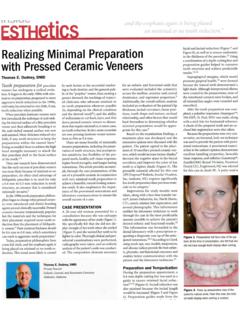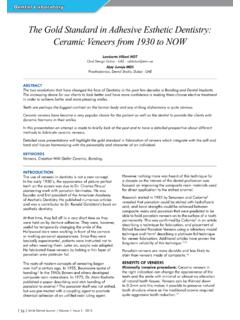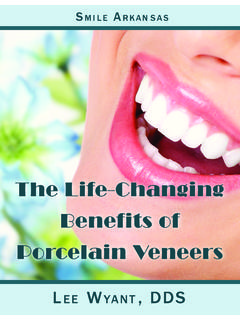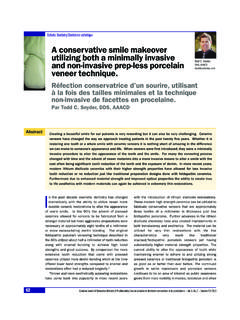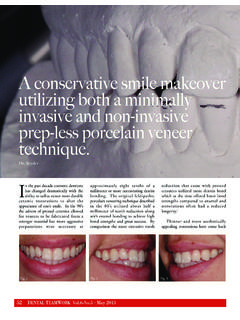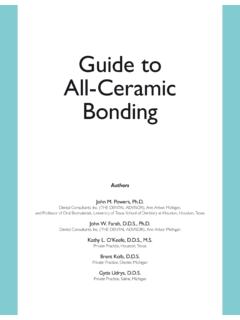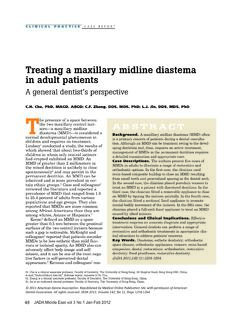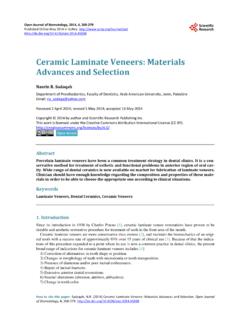Transcription of Trends, Innovations, Controversies, and Clinical Tips ...
1 trends , Innovations, controversies , and Clinical tips Presenter: Dr. Damon Adams 6 PACE/CERP CEUs In this information-packed scientific program, Dr. Adams, from his unique perspective as editor-in-chief of one of North America's leading Clinical and news journals, will present an engaging presentation focused on current trends , controversies and innovations. He will be placing a special emphasis on a variety of Clinical and treatment planning tips designed to assist the dentist and team in choosing and successfully implementing the latest lab-fabricated all-ceramic dental materials and treatment protocols. This science-based presentation is recommended for doctors and dental laboratory technicians.
2 Learning Objectives (as time allows): Identify classifications/indications for the latest lab-fabricated dental materials Advantages and disadvantages of each class of modern all-ceramic materials Learn diagnosis and treatment planning principles to assist in selection of all- ceramic materials 100% zirconium restorations: Evidence-based data versus future challenges? Latest preparation and core build-up requirements for lithium disilicate and monolithic zirconia restorations New translucent anterior zirconia options: indications, special cautions, and future challenges Update on surface treatment protocols and cements for all-ceramic materials Are all-ceramics always the best choice?
3 What are some of the current alternatives? An evidence-based prophylaxis protocol for maintaining composite, all-ceramic and ceramic-based restorations 2017 Adams Dental Seminars LLC. All Rights Reserved Classification of All-Ceramic Systems Glass-Based Ceramics (mainly silica [silicone dioxide/quartz] with or w/o crystalline fillers). Aluminosilicates, known as feldspars in nature, are modified in various ways to create glass and other synthetic ceramics. 1) Leucite-Reinforced (Low-to-moderate leucite-containing porcelains=feldspathic porcelain .). 2) Leucite-Reinforced (High leucite-containing porcelains). Leucite reinforced copings (such as IPS Empress Esthetic [Ivoclar Vivadent], Cerpress SL (American Dental Supply), Finesse Pressable [Dentsply Sirona]).
4 Indications: Crowns, veneers, inlays, onlays Cementation: Bonded only (silane or a universal primer required); DC or LC ( veneer ) resin cements 3) Lithium Disilicate (Aluminosilicate glass, with lithium oxide.). This class of materials was introduced in the late 1990's as conventionally pressed lithium disilicate copings layered with compatible (lithium oxide containing) porcelains (IPS Eris [Ivoclar Vivadent]; and OPC 3G. [Pentron). Layered and monolithic restorations can be fabricated using this class of all-ceramic. Indications: Crowns, inlays/onlays, veneers, and 3u anterior bridges Cementation: Conventional cement, or adhesively bonded (preferred) with silane or universal primer and a DC.]
5 Resin cement. All veneers must be adhesively cemented using a LC resin cement. (Note: Preparations must have adequate retention/resistance form if conventional cement is used.). IPS CAD (LT [low translucency] used for fabricating fully anatomical crowns/cutback and veneering, MO. [medium opacity] used for frameworks with final veneering). Indications: Crowns, partial crowns, inlays/onlays, veneers ( ) and occlusal veneers, and 3u anterior bridges Conventional cement, or adhesively bonded (preferred) with silane or universal primer and a DC resin cement. All veneers must be adhesively cemented using a LC resin cement. (Note: Preparations must have adequate retention/resistance form if conventional cement is used.)
6 IPS Press (LT, MO, HT (high translucency) lithium disilicate material. Indications: Anterior and posterior full and partial coverage crowns; bridges for the anterior and premolar region and implant superstructures; minimally invasive inlays and onlays ( mm min.) and thin esthetic veneers ( mm). Conventional cement, or adhesively bonded (preferred) with silane or universal primer and a DC resin cement. All veneers must be adhesively cemented using a LC resin cement. (Note: Preparations must have adequate retention/resistance form if conventional cement is used.). IPS Press HT is an example of one system that allows laboratory technicians to create minimally invasive veneers pressed (at ), expanding the indications to include inlays/onlays.)
7 (A special note on fluorapatite glass ceramic. Only one option in this category called IPS (Ivoclar Vivadent) This highly esthetic layering porcelain for PFMs features low wear of opposing natural dentition.). Polycrystalline Ceramics (Metal Oxide Ceramics). 1) Aluminum oxide Hand painted slip that is sintered and glass infiltrated Vita In-Ceram Alumina [Vident]). Electrolayered, sintered, glass infiltrated (WolCeram Alumina [Vident]). CAD/CAM (Procera Alumina [Nobel Biocare]). Indications: Crowns, 3u anterior bridges (watch manufacturer minimum dimension requirements). Cementation: No silane; universal primer OK. Conventional or DC resin cements. (An additional and now rarely used subcategory: alumina magnesia (Vita Inceram Spinell [Vident] and Wolceram [EP].
8 Spinell [Vident]). 2) Zirconium oxide (often referred to as zirconia) Layered and monolithic restorations available. Hand-painted slip that is sintered and glass-infiltrated (In-Ceram Zirconia [Vident]). Electrolayered, sintered, glass-infiltrated (WolCeram Zirconia [Vident]). CAD/CAM Yttrium-stabilized (Y-TZP) (Examples include: Lava and Lava Plus [3M]; IPS ZirCAD [Ivoclar Vivadent] ; Cercon (Dentsply Sirona); Zenostar [Ivoclar Vivadent]). Indications: Clinical indications vary by material/brand/manufacturer. Cementation: Conventional or adhesive cementation. No silane required. With resin cements, internal surface application of a zirconia primer (Z-Prime Plus [Bisco]) or a universal primer (such as Monobond Plus [Ivoclar Vivadent]); or can use universal adhesives as a primer.
9 Hybrid Ceramics (zirconia-reinforced lithium silicate [ZLS]). Celtra Duo and Celtra Press (Dentsply Sirona); Obsidian (Glidewell Labs); Suprinity PC (Vita). Polymer Ceramics (or Ceramic/Polymers or also referred to as Nano Ceramics). Lava Ultimate (3M) block introduced in 2012. Enamic (Vident) introduced in 2013; Cerasmart (GC America) in 2014. (Caution! Indications vary between these brands within this category of materials 2. Relative Strengths of Non-Metal Coping/Monolithic Systems (Listed in order of lowest to highest relative strength). pressed leucite-reinforced coping systems (150+ MPa) (IPS Empress, IPS Empress Esthetic, Authentic, OPC, Cerpress, Finesse Pressable).)
10 Polymer ceramics (Ceramic/Polymer) (230+ MPa) (Lava Ultimate (3M), Enamic (Vita), CeraSmart (GC ). Alumina-magnesia coping systems (350 MPa) (In-Ceram Spinell, WolCeram Spinell. Note: WolCeram is reportedly stronger due the electrolayering process and a longer sintering time. Monolithic lithium disilicate systems (500+ MPa) (IPS [Ivoclar Vivadent]. Aluminum oxide hand-painted slip coping system (500+ MPa) (In-Ceram Alumina, WolCeram Alumina) Note: WolCeram is reportedly stronger due the electrolayering process and a longer sintering time. CAD/CAM Aluminum oxide coping systems (600+ MPa) (Procera AllCeram, CEREC inLab Alumina). Zirconium dioxide hand-painted slip coping systems (700 MPa) (In-Ceram Zirconia, WolCeram Zirconia) Note: WolCeram is reportedly stronger due the electrolayering process and a longer sintering time.)))
